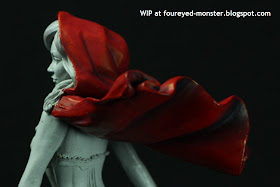Of all the colours on the Nocturna Models Le Petit Chaperon miniature, red is to me the most important. Henceforth, every other colour I put on her will need to complement the shade of red I have painted on the hooded cloak. Targeting a hue between an intense bright red bordering on orange and an earthy brown red, I sought a middle ground that hopefully sees the red 'pop' without being too overpowering. I will only know for sure if I have achieved this after painting the rest of her.
 |
| Nocturna Models Le Petit Chaperon gets a splash of red |
To prevent an overdose of red I am limited the painting of this colour to only her hooded cloak, shoes and sock garters. Personally, I think painting too much red would overwhelm this miniature and make it look too one dimensional and flat. Moreover, she is Red Riding Hood not the Lady in Red.
 |
| Other than her iconic hooded cloak, Le Petit Chaperon has red shoes and sock garters |
 |
| Two sides of the red cloak worn by Le Petit Chaperon |
Previous blending and layering practice with red colours definitely helps as every new attempt sees smoother transitions from the shadows all the way to the highlights. It's not perfect yet but I'm getting there one layer (or is it blend) at a time. Red is a lovely colour to work with but hard to perfect.
 |
| Front view of the Nocturna Models Le Petit Chaperon, work-in-progress |
 |
| A dynamic sculpture of Red Riding Hood's hooded cloak made painting it a real pleasure |
To enhance the reds, I used blue shadows instead of black. I was fortunate enough to get hold of a really old White Dwarf magazine (WD362 February 2010) which back then had the excellent
Ask 'Eavy Metal articles, and this issue touched on the use of alternate colours as shadows for reds.
 |
| Blue shadows were used to give the reds some 'pop' |
 |
| Highlights looked yellowish hence were limited lest they reduce the hooded cloak's overall redness |
 |
| Best view of the blue shadows on Le Petit Chaperon's hood |
 |
| Le Petit Chaperon's blouse is screaming out for a sheer fabric treatment, tastefully done of course |
Meanwhile, her highlights were purposely limited to as few areas as I could get away with. I noticed that if I went crazy with the highlights, the cloak started to look more orange than red. At one stage I had to tone down the highlights with some mid-tone glaze. But that being said, there is a case to be argued for more highlights on her hood (not cloak) especially at the top most part.
 |
| It doesn't matter if it's Prada or Bata, red shoes are always hot |
 |
| Top view of Le Petit Chaperon's hooded cloak |
Also when painting the reds in Le Petit Chaperon, I changed my song playlist from its default blues setting to one with a variety of genres but still dealing with sadness and melancholy. Well it started super sad with one of my favourite country songs
Stay by Sugarland but ended in an upbeat song that was released when I was still in my mid-20's (deary me I feel old) i.e.
Kiss Me by Sixpence None The Richer. Both songs and the many in between set up a nice little mood progression for my painting session, transitioning from sad to happy. It never hurts to have good music to paint to!
 |
| Jennifer Nettles and Leigh Nash both offer contrasting skin/hair colour options as well as music accompaniment |
Incidentally, the lead singers of the respective music groups I
mentioned namely Jennifer Nettles and Leigh Nash also offer an
interesting contrast in skin and hair colours, one of which I may yet adopt for
Le Petit Chaperon. I leave you with this lovely line from a Sugarland hit ... 'I need a little less hard time, I need a little more bliss'; I hope you have less of one and more of the other in your life.








































.jpg)









